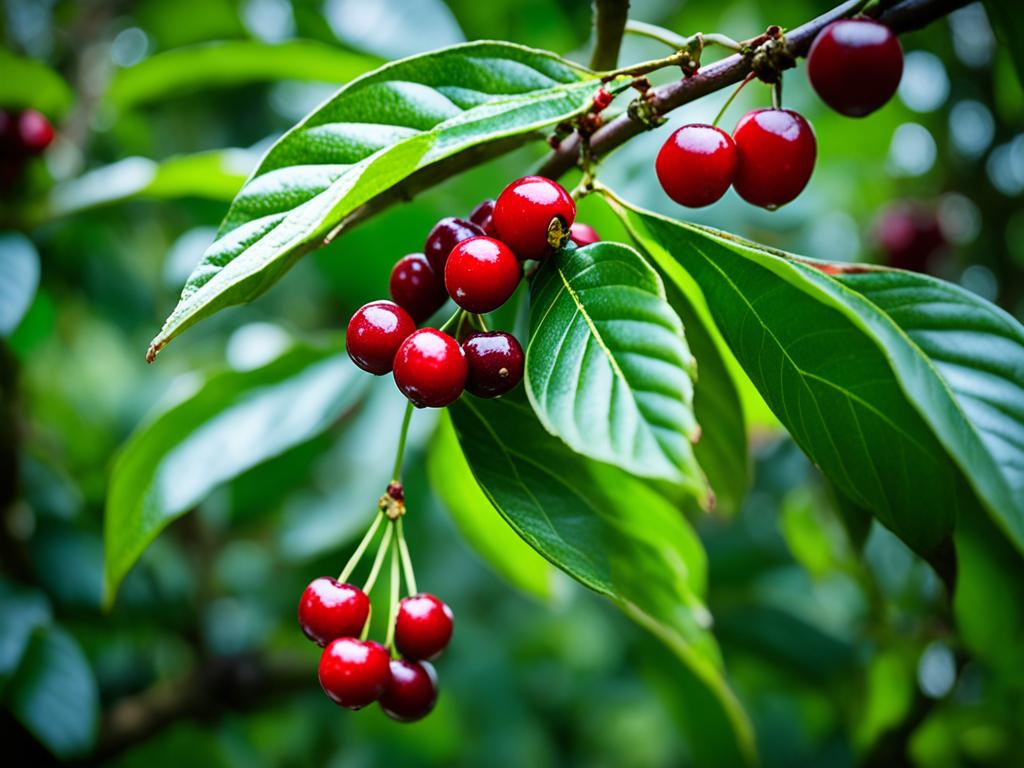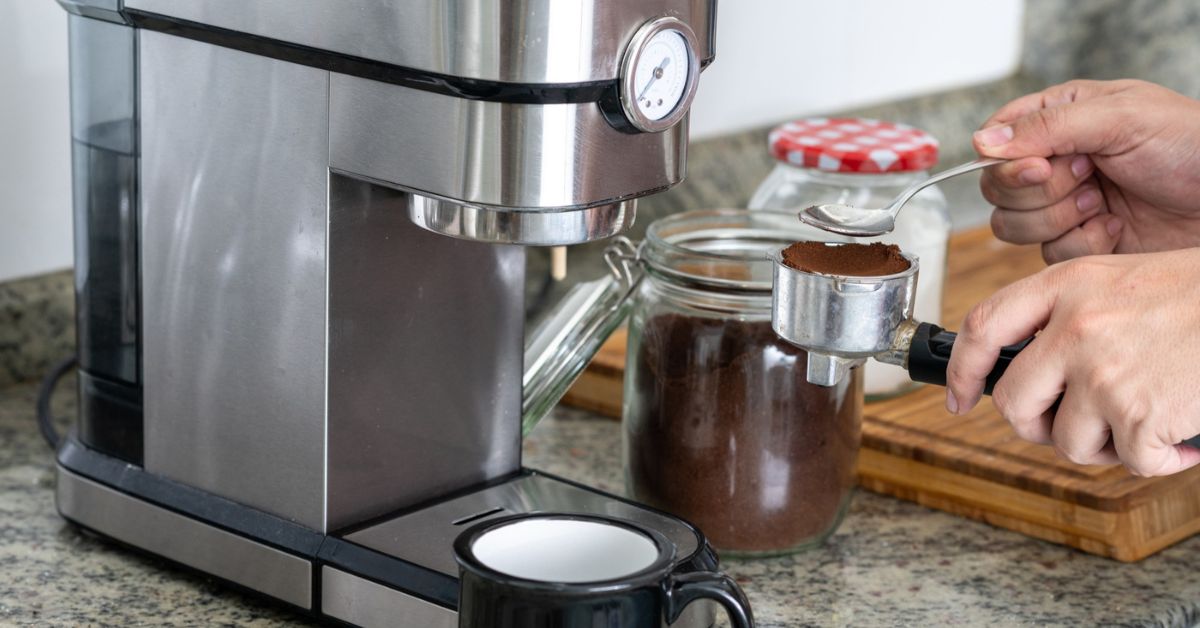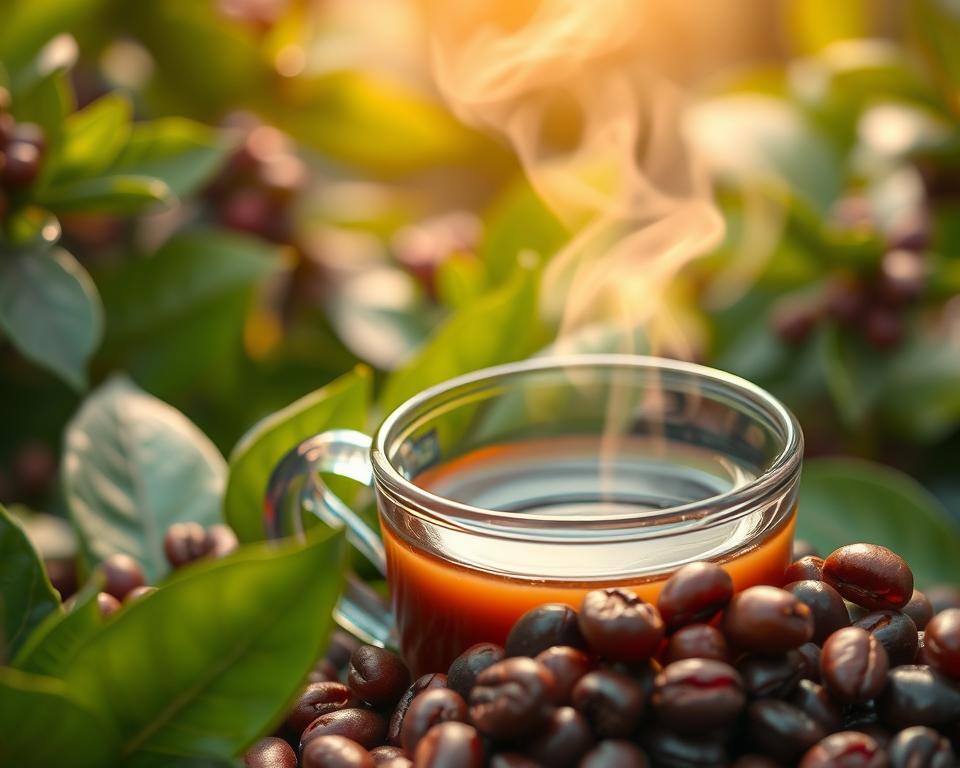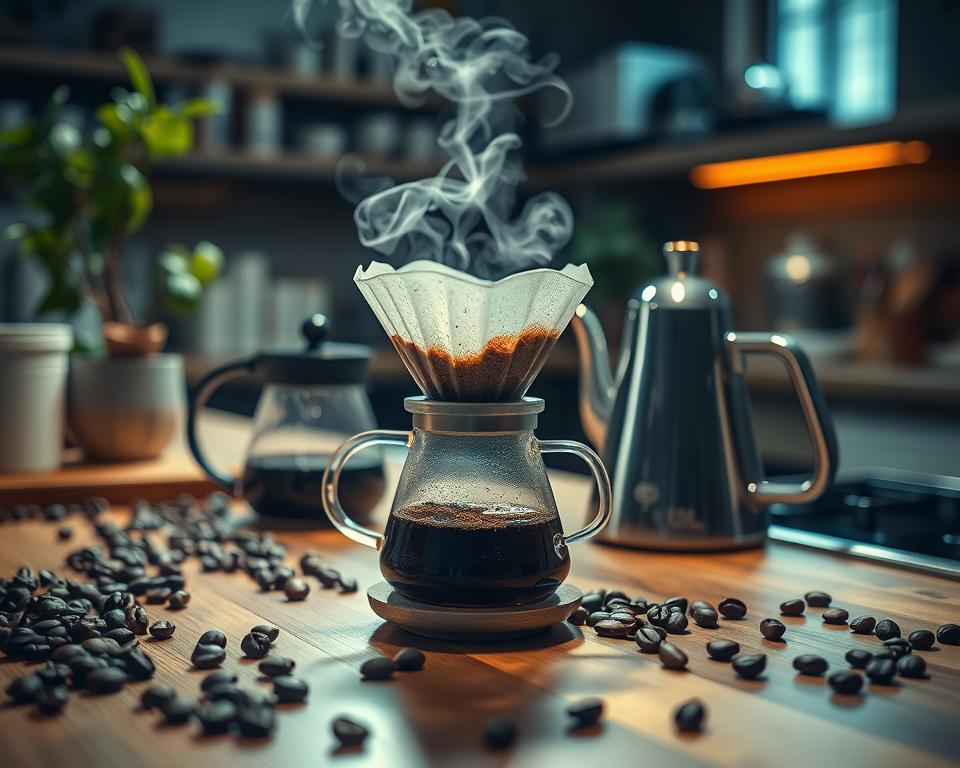This coffee started in Ethiopia’s Gori Gesha forest, and now it wins auctions with record prices.
As you taste its complex flavours, you’ll understand why this brew is so loved.
- Key Takeaways
- Geisha coffee is more than just a rare find; it’s a luxurious brew that has elevated coffee artistry.
- The unique coffee flavour of Geisha beans is as exclusive as their origin story.
- Record-breaking auction prices reflect the high esteem of Geisha coffee in the global market.
- Experiencing the taste of Geisha coffee is akin to indulging in a sensory masterpiece.
- Award-winning reputations and meticulous cultivation underscore Geisha coffee’s elite status.
Unveiling the Allure of This Rare Coffee.
This coffee takes us back to Ethiopia, in the small Gesha village. It was in 1931 that its unique aroma was discovered. This rare Arabica species then moved to Costa Rica in the 1950s. It finally flourished in Panama, thanks to its resistance to leaf rust.
The journey of this luxurious coffee brew is fascinating. It wasn’t highly valued at first. But in 2004, the Peterson family’s presentation at the “Best of Panama” changed everything.
They sold it for over $20 per pound. This story shows the bean’s uniqueness and luxury.
This coffee is now grown far beyond Panama. It’s found in Central America, Africa, and Asia. Yet, Panamanian geisha remains top for its unmatched aroma and quality.
It’s unique how one coffee has touched so many corners of the world.
| Region | Year of Introduction | Average Auction Price | Notes |
|---|---|---|---|
| Ethiopia (Origin) | 1931 | Varies | Birthplace of the geisha varietal; unique flora contributes to its aroma |
| Costa Rica | 1950s | N/A | Introduced for its leaf rust resistance, further research ensued |
| Panama | 2004 (Notable auction) | Over $20/lb | Peterson’s batch catalyzed its fame as a luxurious and rare brew |
This coffee is like no other brew to me. When I drink it, I’m not just enjoying a beverage. I’m experiencing a rich heritage. Every sip brings its extraordinary story to life.
The Storied Journey of Geisha Coffee Origins
I’m drawn to the geisha coffee flavour profile, a taste that captures Panama’s land. Its journey to fame began in Ethiopia, near the small Gesha village.
This is where the unique aroma of geisha coffee started.
How History Shapes Geisha Coffee’s Prestige
The tale of Panamanian Geisha coffee is a story of growing prestige. It traces back to Ethiopia. There, its jasmine scent won the 2004 “Best of Panama” contest.
This win made the world notice. It also celebrated the Peterson family’s hard work in coffee farming.
Contrasting Geisha Coffee with Historical Varietals
Geisha coffee is different from other historical coffee varietals. It’s not just the taste. Its ability to resist coffee leaf rust sets it apart.
While other beans speak of their origins, Panamanian Geisha tells a unique story.
It’s a tale of rarity and supreme quality for those who love coffee.
In Panama’s Boquete region, coffee cultivation has elevated Geisha coffee. This success comes from growing these high-quality Arabica plants at high altitudes.
These efforts have pushed its market price to record highs.
Savouring the Flavor Profile
Tasting geisha coffee is like going on a fancy journey. Each sip feels like an adventure. The Geisha coffee from Hacienda La Esmeralda is a favorite.
It’s known for its jasmine, bergamot, and tropical fruit flavours.
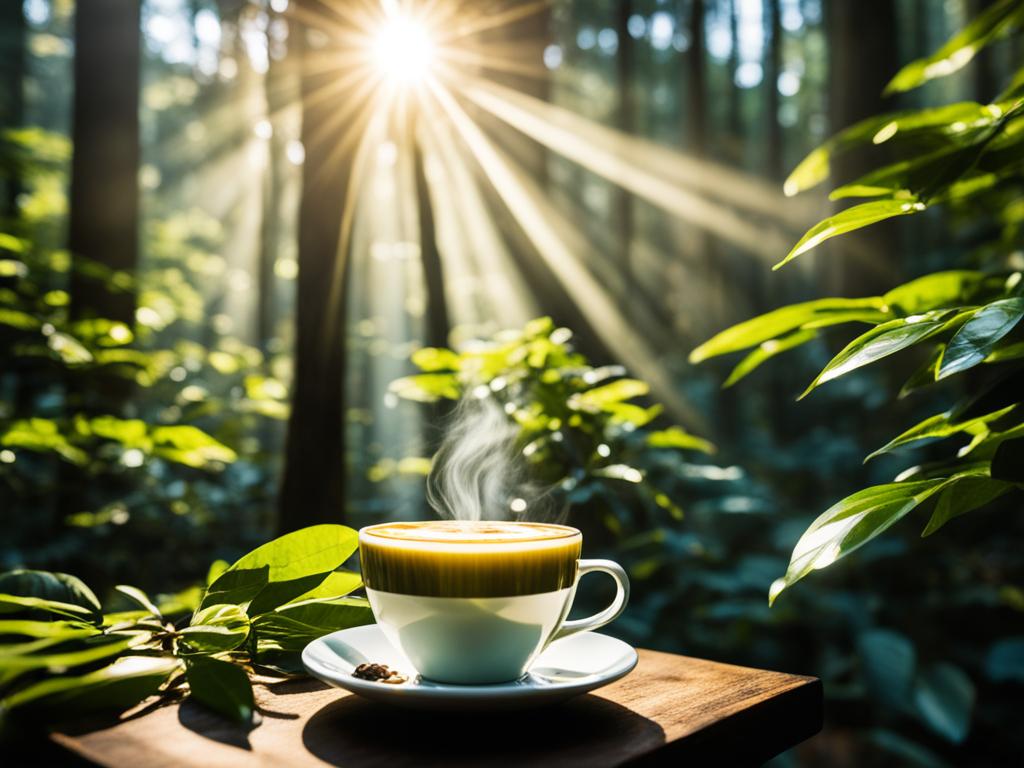
Many coffee varieties have their own unique flavours, like Blue Mountain from Jamaica. But Geisha coffee is truly special. It’s a luxurious symbol in the coffee world.
The Symphony of Flavors in Geisha Coffee
Describing Geisha coffee isn’t simple. Its flavours are rich and complex. Honey processing adds to its unique sweetness. It’s a premium taste that I love sharing with others.
Connoisseurs’ Take on Geisha Coffee Tastes
For coffee lovers, Geisha is top-notch. It comes in many flavours, from light to chocolaty. These flavours bring happiness to those drinking high-quality Geisha coffee.
| Coffee Variety | Tasting Notes | Processing Method | Origin |
|---|---|---|---|
| Hacienda La Esmeralda | Jasmine, Bergamot, and Tropical Fruits | Natural/Washed | Panama |
| Blue Mountain | Bold, Smooth, and Nutty | Washed | Jamaica |
| Molokai | Rich, Complex | Natural/Washed | Hawaii |
| Los Planes | Luxurious, Exclusive Blend | Varied | El Salvador |
Looking back, exploring single-origin coffees has been eye-opening. Beans like El Injerto from Guatemala show how processing affects flavor. It’s about discovering a world of coffee experiences.
Decoding the Exorbitant Geisha Coffee Price
Enjoying a great cup isn’t just about the taste. It’s also about knowing the story behind Geisha coffee. The geisha coffee price is high, so let’s explore why this coffee is so special.
Why Your Cup of Geisha Coffee Costs More
Ever wonder why Geisha coffee feels like a luxury? It’s more than just coffee; it’s luxury in a cup. From selective harvesting to an artful roast, each step ensures quality.
This makes every bean valuable.
Geisha Coffee on the Spectrum of Premium Coffees
In the world of premium coffees, geisha coffee stands out. It’s not just another cup of coffee. It offers unique flavours that beat the most expensive coffee.
Its rarity and taste make it highly valued.
| Aspect | Geisha Coffee | Luxury Competitors |
|---|---|---|
| Cost per Pound | $2,500+ | $100-$500 |
| Taste Profile | Floral, Citrus, Unique | Varied, Less Distinct |
| Market Demand | High | Moderate |
| Exclusivity | Very Rare | Less Rare |
| Awards/Auctions | Top Geisha Coffee Ranking | Seldom Wins |
In my journey to understand this bean, one thing is clear:. For fans of the luxury coffee market, geisha coffee is more than a fad. It symbolises the peak of coffee excellence.
Geisha Coffee vs. Other Varietals: A Thorough Comparison
Exploring this coffee comparison highlights its uniqueness in growth and taste. Grown mainly in Panama’s Boquete region, Geisha offers a rich flavour palette that grabs attention.
Unlike other coffee varietals like Bourbon and Pacamara, Geisha’s taste—full of floral, jasmine, chocolate, honey, and black tea notes—is unmatched. This has sparked many discussions on coffee bean differences.
Now, let’s discuss what sets this coffee farming apart. Its unique processing, including careful handpicking, ensures only the best cherries are selected. This detailed process, combined with both wet and dry methods, brings out a flavour complexity that’s rare in other coffees.
Good farming practices, such as strategic planting and disease management, are vital for producing top-quality.
But Geisha faces its own challenges, like susceptibility to coffee berry disease and nematodes.
However, in the global market, especially in Asia, the clear preference is for Geisha’s distinct flavours over other Geisha versus Arabica beans. This choice is influenced by Geisha’s unique taste profiles.
| Characteristic | Geisha Coffee | Other Arabic Varietals |
|---|---|---|
| Price | Commanding record auctions (over $1000/lb) | Generally lower; varies by specific varietal |
| Flavor Profile | Floral notes: jasmine, honey, and black tea | Can range from fruity to chocolatey |
| Disease Resistance | Tolerant to leaf rust, susceptible to berry disease | Varies; some are more disease-resistant |
| Elevation Impact | Thrives at higher elevations for dense flavor | It depends on varietal; not all require high elevation |
| Harvesting Method | Handpicked for ripe cherries | Varies, but not typically as selective |
| Market Demand | High demand, especially in Asia | Widespread but less coveted |
| Farming Practices | Premium techniques, strategic planting | Standard to premium, based on varietal |
In wrapping up, diving into Geisha’s world has shown me its deep, standout nature. It’s not just the taste but also the careful farming and processing that puts Geisha above other coffee varietals.
The Art of Geisha Coffee Brewing Methods
Brewing this coffee is an art of precision and passion. I carefully pick beans that bring Panama’s rich earth into every cup.
The flavours range from jasmine to bergamot and fruitiness.
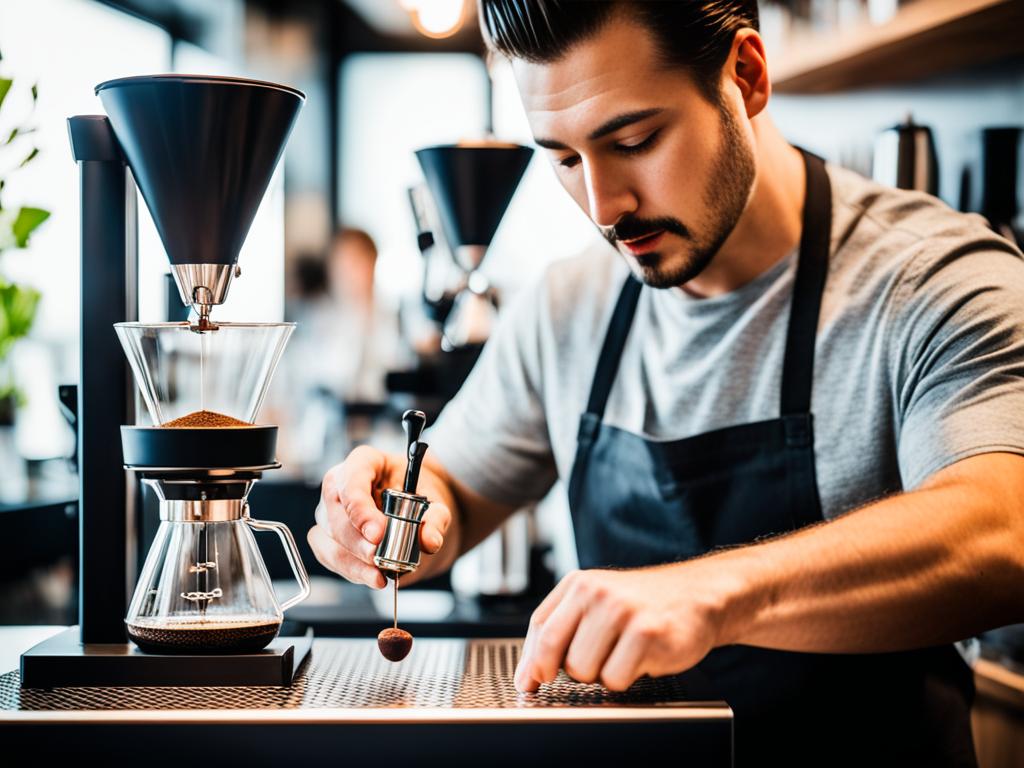
I love using the pour-over method for this coffee. It allows me to bring out the coffee’s true character. With my Hario V60, I honour the effort that goes into every bean of Geisha coffee.
Brewing this coffee to perfection
Good equipment is key. A consistent grind, a quick bloom, and water just off the boil unlock Geisha’s taste. The pour-over process adds discipline and beauty to my mornings.
The Impact of Brewing on Geisha Coffee’s Flavour
Adjusting grind size, water heat, and pour technique makes a big difference. It lets me play with the flavours, aiming for the ultimate Geisha coffee experience.
I honour its journey from Panama to me with every sip.
| Brewing Technique | Optimal Temperature | Grind Consistency | Tasting Notes |
|---|---|---|---|
| Pour-Over (Hario V60, Chemex) | 200°F (93.3°C) | Medium (Sea Salt) | Floral, Jasmine, Citrus |
| French Press | 195-205°F (90.6-96.1°C) | Coarse | Rounded, Full-bodied |
| AeroPress | 185-205°F (85-96.1°C) | Medium-fine | Complex, Clean, and balanced |
| Cold Brew | Room Temperature | Extra Coarse | Smooth, Mellow, and Sweet |
Exploring the Soaring Popularity of Geisha Coffee
The popularity of this coffee is skyrocketing. Its rich aroma and the story behind every cup fascinate me. This coffee comes from Panama’s lush highlands and stands out in the world of high-end specialty coffees.
People are now craving this unique brew for its complex flavors.
Why Everyone Wants a Taste of This Coffee
The demand for this coffee is booming globally. Cafés and coffee lovers are all chasing this exceptional bean. Last year, a pound of Panama’s best geisha sold at auction for a record $6,034.
This showcases its luxury status in the coffee world. Its influence is big, setting trends in premium coffee. For example, Café Unido in Panama City offers it for $35 a pound, a price unmatched by other coffees.
How This Coffee is Redefining Coffee Culture
This Panama bean is changing the coffee scene. It pushes coffee fans to seek new tastes and levels of elegance. Coffee is no longer just for a caffeine boost.
It’s an experience of culinary art, highlighted by geisha coffee. This bean’s effect is reshaping the industry, promising a future of refined taste and the highest quality in coffee.
A Peek into the Prized Geisha Coffee Farms
I’ve always been drawn to specialty coffee agriculture, especially the celebrated Geisha coffee farms. The dedication in each coffee cherry is awe-inspiring.
Tucked in Panama’s landscapes, these farms are coffee cultivation’s peak. The Black Jaguar Geisha coffee, sold for $2,000 per pound, shows their luxury coffee production.
During my visit to a famous Panamanian coffee farm, I witnessed how the right environment boosts coffee quality. Gesha Village Coffee Estate covers 471 hectares, showcasing how location choice is crucial.
Their coffee cherries, sun-dried for up to 30 days on African beds, gain unique flavours this way.
Despite the c-market’s low price for coffee, these farms aim to close the income gap for small producers. Proud Mary Coffee Roasters bought Black Jaguar Geisha to shine light on these issues. The Sustainable Coffee Buyers Guide and fair wage efforts in Colombia give hope for a balanced future.
These farms produce rare coffees—just 10% of their total—but they are highly sought after. They often score over 90 by the Specialty Coffee Association.
The original seeds were found in Gori Gesha Forest. Their meticulous cultivation delivers floral and fruity coffees. Carmen Estate Gesha even fetched US $10,005 per kg at the Best of Panama auction.
Conclusion
As we conclude, this coffee stands out not just as a beverage but as the pinnacle of coffee indulgence. It’s renowned for its superior taste and the journey it takes from seed to cup.
Take Finca Santa María’s Gesha beans, for example. Even after roasting, they maintain high chlorogenic acid levels, proving their top-notch quality and the careful growth process they undergo.
This coffee truly sets the standard for a matchless experience. During the US Barista Championship, Gesha’s presence was undeniable. Most of the top contenders chose this variety for its complex flavour and outstanding taste.
Some even went for the unique taste of anaerobic fermentation. These high marks solidify its status as the epitome of coffee excellence.
Whether from Panama’s hills or Colombia’s valleys, it tells a tale of rarity and dedication. The record prices it fetches, like the Lamastus family’s sales, highlight its appeal to aficionados.
It’s more than a drink; it’s an elevated experience that rewards the efforts of its growers. With its steep price and increasing popularity, it’s evident. This coffee remains a luxury in the world of coffee.
FAQ
What is Geisha Coffee?
This coffee is a special and rare type of coffee. It is known for its unique taste, which includes floral and fruity notes. This Arabica variety is high-quality and provides a unique coffee experience.
What Are the Origins of Geisha Coffee?
How Does History Shape Geisha Coffee’s Prestige?
Geisha coffee was once overlooked, but it gained fame in the early 2000s. The Peterson family highlighted it in 2004 at the “Best of Panama” auction. Its outstanding quality made it very prestigious.
How Does Geisha Coffee Contrast with Historical Varietals?
Geisha coffee is different because of its amazing taste, rarity, and the hard work needed to grow it. These qualities make it a unique and highly valued Arabica coffee.
What is the flavour profile of this coffee?
Geisha coffee has a mix of tastes like jasmine, bergamot, peach, and tropical fruits. This makes its flavour complex and gives it a premium feeling different from other coffee types.
Why is Geisha Coffee so expensive?
Its high price comes from being rare, hard to cultivate, and producing small amounts. These qualities make it the most expensive coffee, symbolising luxury in the coffee world.
How is Geisha Coffee Different from Other Arabica Varietals?
Its unique taste and specific needs for growing set it apart from other Arabica coffees. The cultivation challenges and its sweet, complex aromas make it standout in the coffee market.
What are the best methods for brewing this coffee?
For highlighting its unique flavours, use AeroPress, French Press, or pour-over methods. An espresso or cold brew can also reveal different sides of its flavor.
Why has Geisha coffee become so popular?
Its unique taste, exclusivity, and the high prices it gets at auctions have made it very popular. People love its rarity and the special taste experience it offers.
Why are Geisha Coffee Farms so renowned?
The farms, especially in Panama, are famous for their perfect conditions, like volcanic soil and high altitudes. These help produce the best quality, making the farms well-known for specialty coffee growing.

